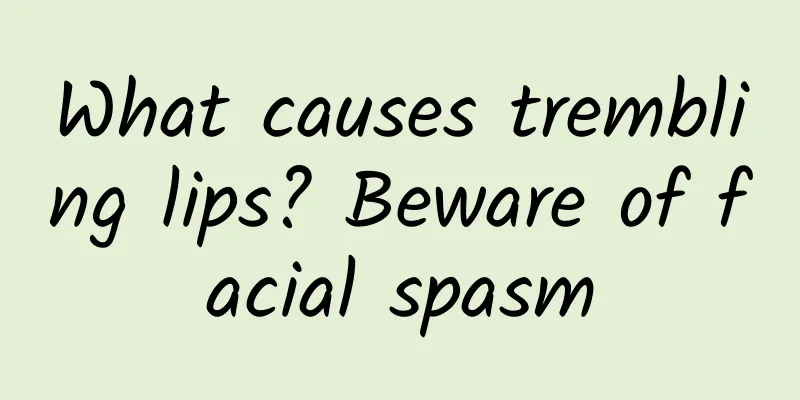What causes trembling lips? Beware of facial spasm

|
Lip trembling, or lip twitching, is often caused by hemifacial spasm. Hemifacial spasm is mostly caused by abnormalities in the facial nerves. This disease can cause mental tension and affect daily work and life, so you should go for a check-up in time. 1. Symptoms and Signs Hemifacial twitching refers to the paroxysmal painless contraction of the muscles innervated by the facial nerve. The first symptom often begins with a slight twitch of the orbicularis oculi muscle of the lower eyelid, gradually spreading upward to all the orbicularis oculi muscles, and then to the lower facial muscles, especially the corners of the mouth. In severe cases, the entire facial muscles and the ipsilateral platysma muscles may spasm. Severe spasm of the orbicularis oculi muscle may make it impossible to open the eyes, thus affecting walking and work, and may be accompanied by mild weakness and muscle atrophy. It worsens when you are stressed, tired, or exercising on your own, and disappears during sleep. Facial muscle twitching is not accompanied by pain, and voluntary contraction of facial muscles is generally not affected when there is no facial muscle twitching. Electromyography revealed that stimulation of the marginal mandibular branch induced the musculus orbicularis oculi. oculi, MOO) myoelectric potential, which is called MD-OC response. Normal people do not have this reaction, but patients with hemifacial spasm all have the MD-OC reaction. 2. Pathological Causes The cause of hemifacial twitching is not clear, it may be caused by ectopic excitation or pseudo-synaptic transmission of the facial nerve. In recent years, there have been reports both at home and abroad that surgical and autopsy materials have confirmed that facial muscle spasm is caused by some kind of compression that causes pathological interference in the conduction of the facial nerve. The vast majority of patients suffer from cross-compression of normal blood vessels, such as the posterior inferior cerebellar artery, anterior inferior cerebellar artery, and vertebral artery. Occasionally, it is caused by compression of the facial nerve root by an aneurysm, arteriovenous malformation, or brain tumor. A very small number of patients experience muscle spasms on the affected side after trauma, tumors or surgery. 3. Disease Diagnosis Need to be differentiated from the following diseases: 1. Functional blepharospasm occurs in elderly women, often bilaterally, without twitching of the lower facial muscles. 2. Habitual tics often occur in children and young people, often presenting as obvious muscle contractions and are related to mental factors. 3. Meige syndrome is also called blepharospasm-oromandibular dystonia syndrome, which is characterized by bilateral blepharospasm, accompanied by dystonia of the mouth, tongue, facial muscles, mandible, laryngeal and cervical muscles. It is more common in elderly women. 4. Neuropsychiatric inhibitors cause facial dyskinesia Patients with dyscinesia have a history of recent use of strong tranquilizers such as perphenazine, trifluoperazine, haloperidol, or metoclopramide, which manifests as compulsive opening or closing of the mouth, involuntary tongue extension or retraction, etc. fold |
<<: Why are your lips itchy? It's important to understand the cause
Recommend
What is the reason for drooling when you wake up in the morning?
In daily life, many people will have a lot of sal...
What common diseases should we pay attention to in autumn?
The seemingly ordinary autumn is neither too cold...
Why does pregnant women's urine smell bad?
After a woman becomes pregnant, the placenta will...
Can I eat yam after abortion?
Abortion is a common method of terminating pregna...
Original formula of Yinqiao Powder
Yinqiao Powder has many functions and effects. Yi...
How to relieve nausea after taking Chinese medicine
Traditional Chinese medicine also has certain sid...
Sequelae of rickets
The main symptoms of rickets are vitamin D defici...
Acute suppurative thyroiditis
The thyroid gland plays an important role in our ...
Tooth decay in children
Because of not paying attention to teeth care and...
How to take Cnidium monnieri for best results
Cnidium monnieri is the seed of a fruit with grea...
What is oral leukoplakia? Causes of oral leukoplakia
Oral leukoplakia is a common oral disease. Plaque...
Are the dental implants secure?
When people reach old age, the function of their ...
Couples massage, four steps to climax quickly
For couples, there are many ways to promote emoti...
What is the method of using toothpaste and baking soda to remove blackheads?
Blackheads are a very unacceptable skin problem, ...
What are the benefits of eating shredded ginger?
Ginger is a food with warming properties. It is u...









